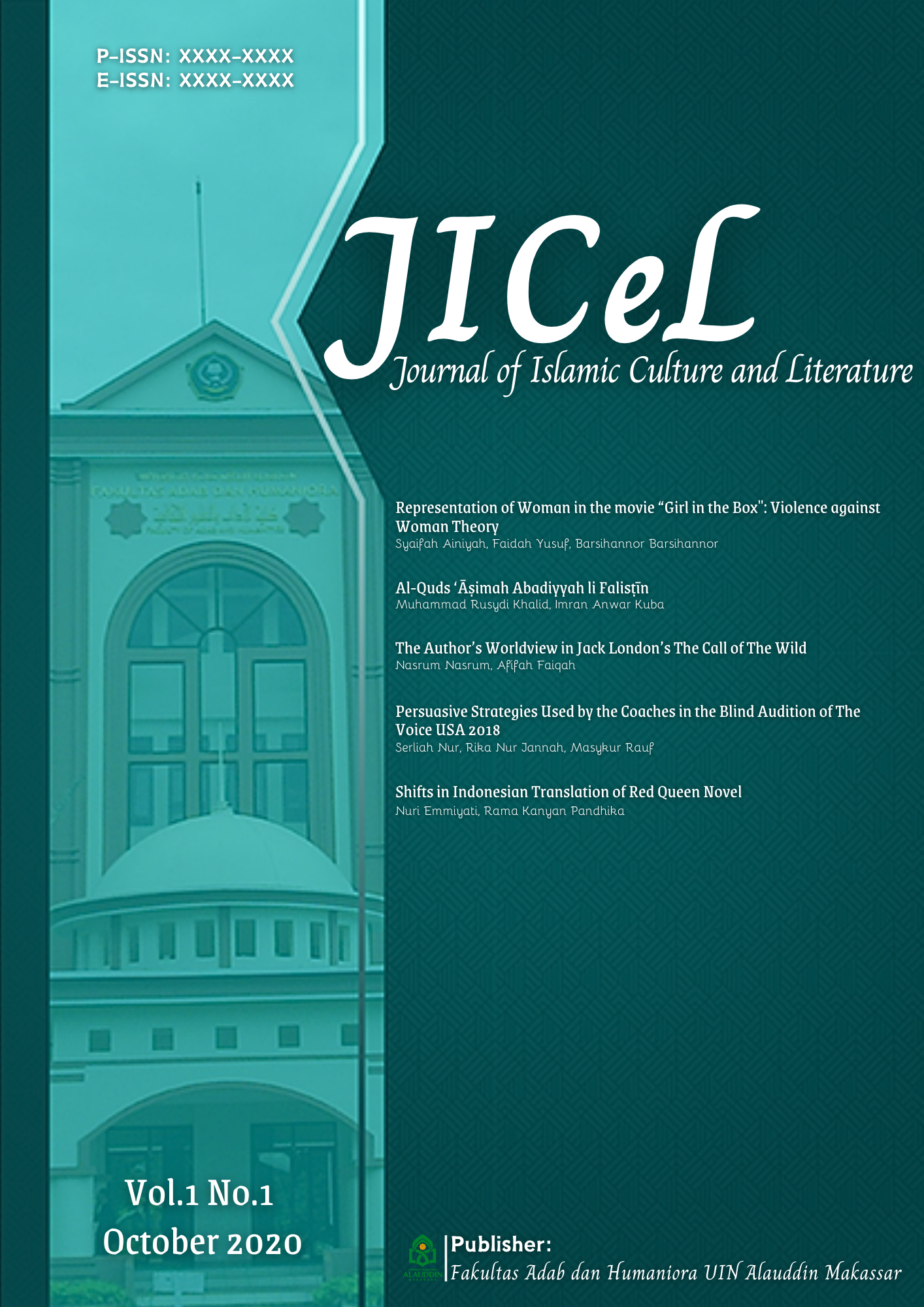Shifts in Indonesian Translation of Red Queen Novel
Abstrak
Shift may occur in translating the text from source language into target language, especially when the two languages have different characteristics both linguistically and culturally. This study aimed to describe the kinds of shift in the Indonesian translation of Red Queen novel, a novel written in English by Victoria Aveyard in which it was translated by Nuraini Mastura. A descriptive qualitative approach was used in collecting and analyzing the data. The data were specifically the uttrances of the main characters in the novel both in the original novel written in English and its Indonesian translation. The data were analyzed referring to Newmark’s theory of transposition or shift of translation. This study revealed that all kinds of transposition or shift occur in translation of Red Queen novel. They are automatic transposition, no grammar equivalence, different ways to express idea, and lexical gap replaced by grammar structure.
Referensi
References
Baker, M. 1998. Routledge Encyclopedia of Translation Studies. USA and Canada: Routledge.
Bull, Victoria. 2012.Oxford Learner’s Pocket Dictionary the 4th Edition. UK: Oxford University Press
Carreres, A. 2006. Strange bedfellows : Translation and Language teaching. The teaching of translation into L2 in modern languages degrees: Uses and limitations. Canadian Translators, Terminologists and Interpreters Council.
Catford, Jhon C. 1965. A Linguistic Theory of Translation: An Essay in Applied Linguistics. London: Oxford University Press.
Chikita, Octavia Aryananta. 2013. Translation Shifts in the Novel “Mansfield Park” by Jane Austen Translated by Berliani Mantili Nugrahani. Jakarta : Universitas Nasional Jakarta.
Hatim, B and Munday, J. (2004). Translations: An Advance Resource Book. London & New York: Taylor & Francis e-Library, (Chapter 1).
Jensen, K.B. and Jankowski, Nicholas W. 2002. A Handbook of Qualitative Methodologies for Mass Communication Research. London: Routledge.
Kothari, C.R. 2004. Research Methodology Methods and Techniques (2ndeds). New Delhi: New Age International.
Larson, Mildred L. 1998. Meaning-based Translation: A Guide to Cross
Language Equivalence (second edition). Lanham: University Press of America.
Massoud, Mary M .F. 1988. Translate to Communicate: A Guide for Translators. Colorado : David C. Cook Foundation.
Maula, Inayatul. 2015. Types Of Translation Shifts Found In ‘The Adventure Of The Speckled Band’ With Catford And Newmark’s Theories. Cirebon : IAIN Syekh Nurjati
Moentaha, Salihen. 2006. Bahasa dan Terjemahan. Jakarta : Kesaint Blanc.
Munday, Jeremy. 2008. Introducing Translation Studies (2nd Ed). New York : Routledge
Multalifa, Siti. 2011. An Analysis of English – Indonesian Translation Shift in the Hannah Banana Short Story by Ribut Wahyudi. Jakarta : UIN Syarif Hidayatullah.
Newmark, Peter. 1988. A Text Book of Translation. New York: Prentice Hall.
Nida, Eugene and Charles R. Taber. 1982. The Theory and Practice of Translation. Netherlands: Second Photomechanical Reprint.
Oetinger Andrew G. 1960. Automatic Language Translation and Technical Aspects with Particular Reference to Russian , Cambridge
Palumbo, G. 2009. Key terms in translation studies. London: Continuum.
Richards, J. C., & Schmidt, R. 2002. Longman dictionary of language teaching & applied linguistics (3rd ed.). Harlow: Longman.
Soemarno.1998. Sedikit Catatan Mengenai Teori Terjemahan. Seminar sehari
bidang Penerjemahan. Surakarta: UNS.
Sugiyono.2008. Kamus Bahasa Indonesia. Jakarta : Pusat Bahasa
Sunarto, Edi. 2015. A translation Shift Analysis of Noun Phrase in Subtitling of Ice Age 4 Movie By Sagaz Net. Surakarta : Universitas Muhammadiyah Surakarta.
Victoria Bull. 2011. Oxford Learner’s Pocket Dictionary. New York : Oxford University Press
Penulis yang menerbitkan karya mereka dalam jurnal ini menyetujui ketentuan berikut:
-
Penulis tetap memegang hak cipta dan memberikan hak publikasi pertama kepada jurnal, dengan karya yang secara bersamaan dilisensikan melalui Creative Commons Attribution License. Lisensi ini memungkinkan orang lain untuk membagikan karya tersebut dengan syarat memberikan pengakuan atas kepenulisan serta publikasi awal dalam jurnal ini.
-
Penulis dapat membuat perjanjian kontraktual tambahan secara terpisah untuk distribusi non-eksklusif versi karya yang telah diterbitkan dalam jurnal ini (misalnya, mengunggahnya ke repositori institusional atau menerbitkannya dalam buku), dengan tetap mencantumkan pengakuan bahwa karya tersebut pertama kali dipublikasikan dalam jurnal ini.
-
Penulis diizinkan dan didorong untuk mengunggah karya mereka secara daring (misalnya, di repositori institusional atau situs web pribadi) sebelum dan selama proses pengajuan. Hal ini dapat mendorong pertukaran akademik yang produktif serta meningkatkan jumlah kutipan lebih awal dan lebih luas setelah karya diterbitkan (Lihat The Effect of Open Access).


